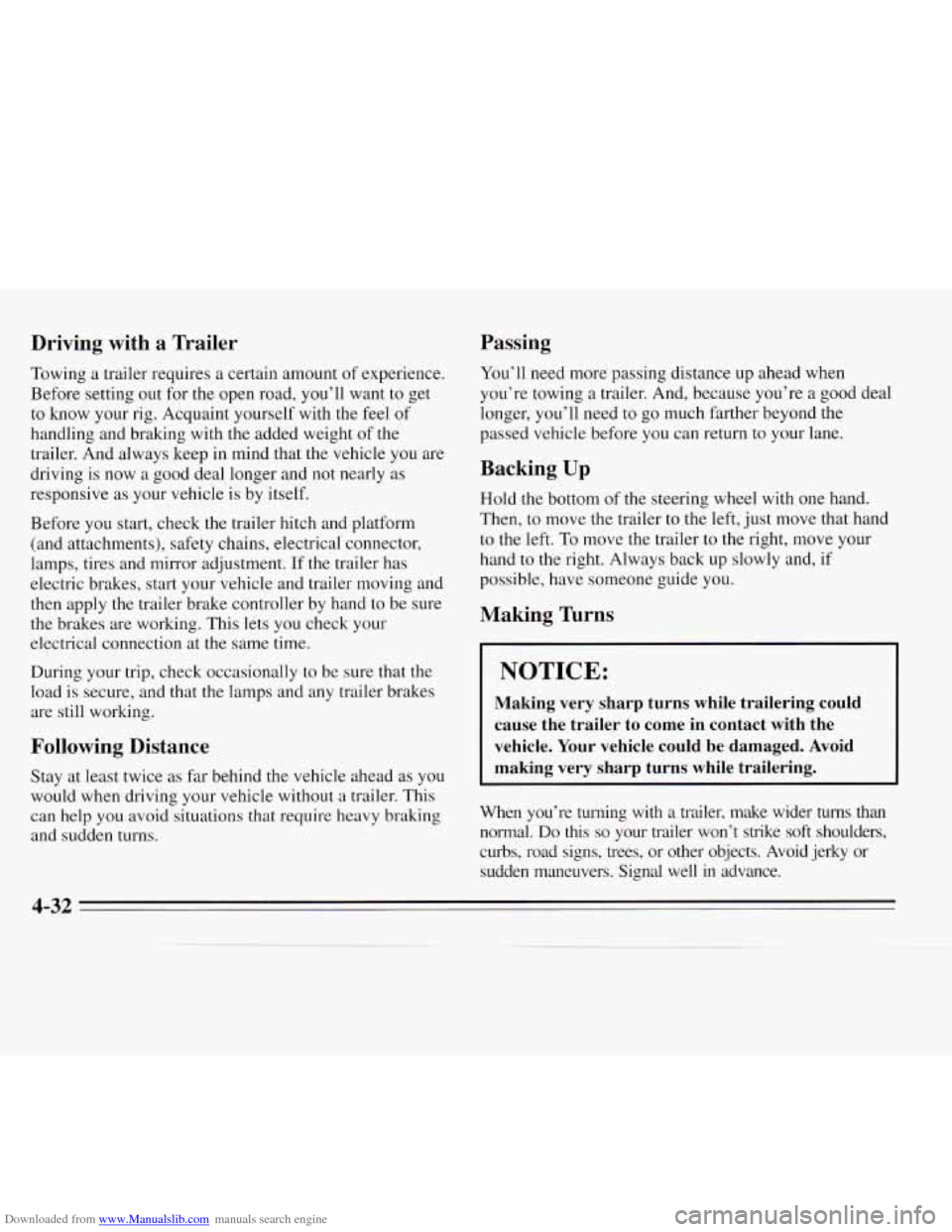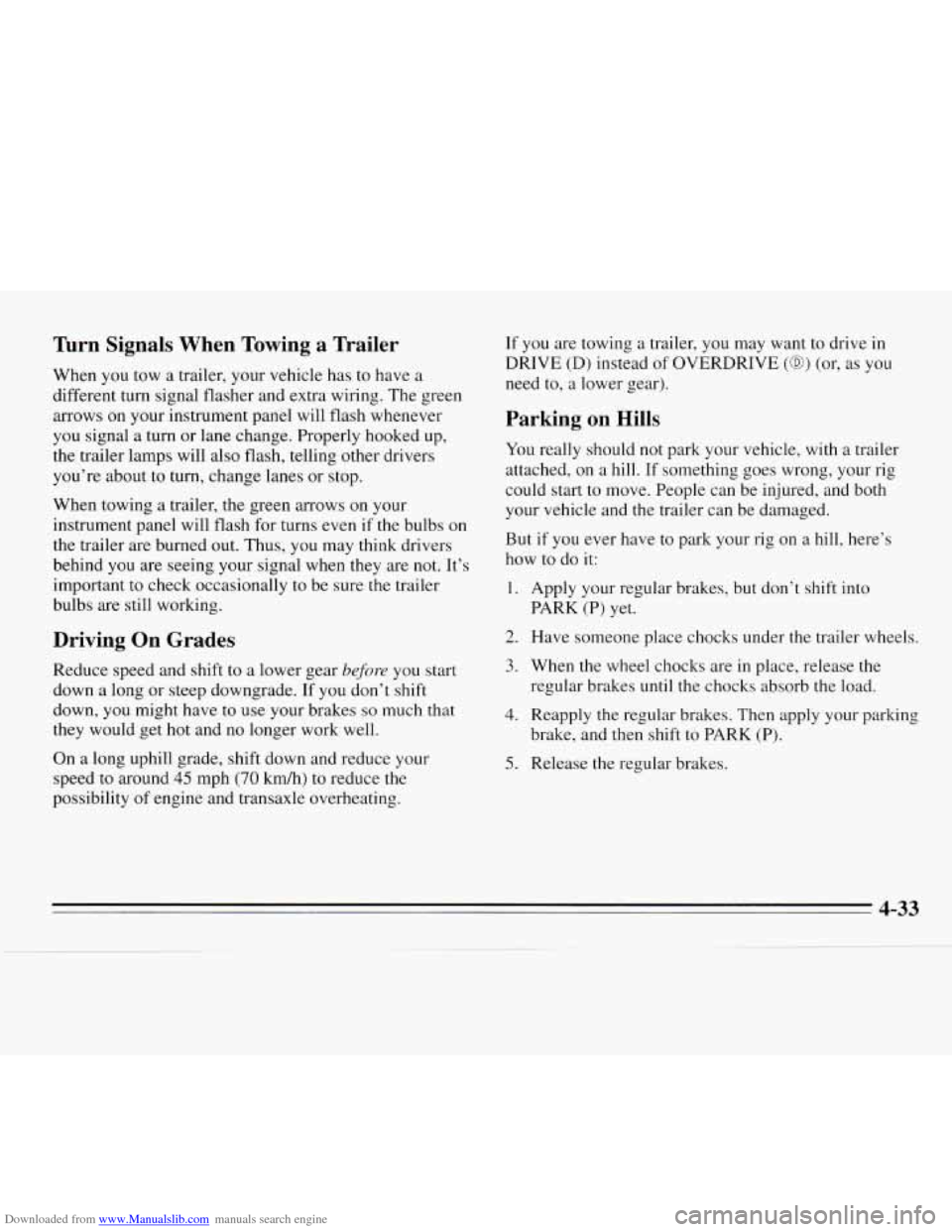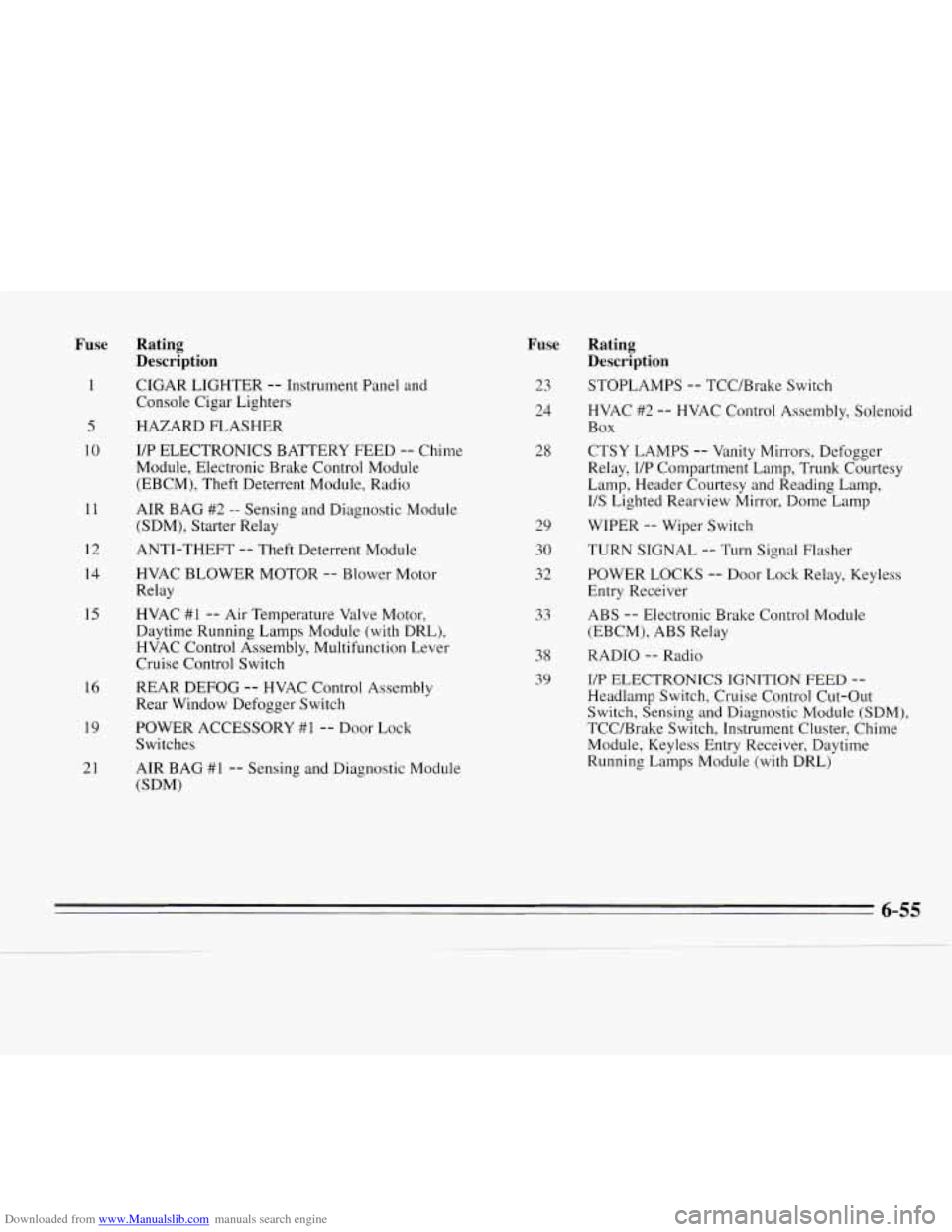Page 160 of 324

Downloaded from www.Manualslib.com manuals search engine Driving with a Trailer
Towing a trailer requires a certain amount of experience.
Before setting out for the open road, you’ll want to get
to know your rig. Acquaint yourself with the feel of
handling and braking with the added weight of the
trailer. And always keep in mind that the vehicle
you are
driving is now
a good deal longer and not nearly as
responsive
as your vehicle is by itself.
Before you start, check the trailer hitch and platform
(and attachments), safety chains, electrical connector,
lamps, tires and mirror adjustment. If the trailer has
electric brakes, start your vehicle and trailer moving and
then apply the trailer brake controller by hand to be sure
the brakes are working. This lets you check your
electrical connection at the same time.
During your trip, check occasionally to be sure that the
load
is secure, and that the lamps and any trailer brakes
are still working.
Following Distance
Stay at least twice as far behind the vehicle ahead as you
would when driving your vehicle without a trailer. This
can
help you avoid situations that require heavy braking
and sudden turns.
Passing
You’ll need more passing distance up ahead when
you’re towing a trailer. And, because you’re a good deal
longer, you’ll need to go much farther beyond the
passed vehicle before you can return
to your lane.
Backing Up
Hold the bottom of the steering wheel with one hand.
Then, to move the trailer to the left, just move that hand
to
the left. To move the trailer to the right, move your
hand to the right. Always back up slowly and, if
possible, have someone guide you.
Making Turns
I NOTICE:
Making very sharp turns while trailering could
cause the trailer to come in contact with the
vehicle.
Your vehicle could be damaged. Avoid
making very sharp turns while trailering.
When you’re turning with a trailer, make wider turns than
normal.
Do this so your trailer won’t strike soft shoulders,
curbs, road signs, trees, or other objects. Avoid jerky or
sudden maneuvers. Signal well
in advance.
4-32
Page 161 of 324

Downloaded from www.Manualslib.com manuals search engine Turn Signals When Towing a Trailer
When you tow a trailer, your vehicle has to have a
different
turn signal flasher and extra wiring. The green
arrows on your instrument panel will flash whenever
you signal a turn or lane change. Properly hooked up,
the trailer lamps will also flash, telling other drivers
you’re about to turn, change lanes or stop.
When towing a trailer, the green arrows
on your
instrument panel will flash for turns even if the bulbs on
the trailer are burned out. Thus, you may think drivers
behind
you are seeing your signal when they are not. It’s
important to check occasionally to be sure the trailer
bulbs are still working.
Driving On Grades
Reduce speed and shift to a lower gear before you start
down a long or steep downgrade. If you don’t shift
down, you might have to use your brakes
so much that
they would get hot and no longer work well.
On a long uphill grade, shift down and reduce your
speed
to around 45 mph (70 km/h) to reduce the
possibility of engine and transaxle overheating. If
you are towing a trailer, you may want to drive in
DRIVE (D) instead
of OVERDRIVE (0) (or, as you
need to, a lower gear).
Parking on Hills
You really should not park your vehicle, with a trailer
attached, on
a hill. If something goes wrong, your rig
could start to move. People can be injured, and both
your vehicle and the trailer can be damaged.
But
if you ever have to park your rig on a hill, here’s
how to do it:
1. Apply your regular brakes, but don’t shift into
PARK (P) yet.
2. Have someone place chocks under the trailer wheels.
3. When the wheel chocks are in place, release the
regular brakes until the chocks absorb the load.
4. Reapply the regular brakes. Then apply your parking
brake, and then shift to PARK (P).
5. Release the regular brakes.
4-33
Page 163 of 324
Downloaded from www.Manualslib.com manuals search engine 0 Section 5 Problems on the Road
Here you’ll find what to do about some problems that
can occur on the road.
Hazard Warning Flashers
Your hazard warning flashers let you warn others. They
also let police know you have a problem. Your front and
rear turn signal lamps
will flash on and off.
Press
the switch to make your front and rear turn signal
lamps flash on and off. Your hazard warning flashers
work no matter what position your key is in, and even
if
the key isn’t in.
5-1
Page 164 of 324
Downloaded from www.Manualslib.com manuals search engine To turn off the flashers, press the switch again. When
the hazard warning flashers are on, your turn signals
won’t work.
Other Warning Devices
If you carry reflective triangles, you can set one up at
the side of the road about 300 feet (100 m) behind your
vehicle.
Jump Starting
If your battery has run down, you may want to use
another vehicle and some jumper cables to start your
Chevrolet.
But please follow the steps below to do it
safely.
I NOTICE:
Ignoring these steps could result in costly damage
to your vehicle that wouldn’t be covered by your
warranty. Trying to start your Chevrolet by
pushing or pulling it won’t work, and it could
damage your vehicle.
5-2
Page 224 of 324
Downloaded from www.Manualslib.com manuals search engine Front Park and Turn Signal Lamp
1. Open the hood. There is one flap on each side of the
radiator.
2. Open the flap by lifting the snap screw.
6-30
Page 228 of 324
Downloaded from www.Manualslib.com manuals search engine Tail/Stop/Thm Signal Lamp
1. Open the trunk. Remove the convenience net if you
have one. Unhook the net from the upper wing nut.
2. Remove the upper
(convenience net) wing
nut, if equipped.
3. Pull the carpet away
from the rear of the
vehicle.
4. Unscrew the two remaining wing nuts.
5. Pull the assembly from the body carefully.
6. To remove a socket, press the tab, turn the socket
counterclockwise
and pull it out.
7. Pull the bulb out. Do not twist it.
8. Push the new bulb into the socket.
9. Replace the socket in the assembly.
10. Tighten the socket (both kinds) by turning it clockwise.
11. Install the assembly and the two lower wing nuts.
12. Replace the carpeting.
13. Replace the upper (convenience net) wing nut, if
14. Replace the convenience net, if equipped.
equipped.
6-34
Page 249 of 324

Downloaded from www.Manualslib.com manuals search engine Fuse
1
5
10
11
12
14
15
16
19
21
Rating
Description
CIGAR LIGHTER -- Instrument Panel and
Console Cigar Lighters
HAZARD FLASHER
I/P ELECTRONICS BATTERY FEED
-- Chime
Module, Electronic Brake Control Module
(EBCM), Theft Deterrent Module, Radio
AIR BAG #2
-- Sensing and Diagnostic Module
(SDM), Starter Relay
ANTI-THEFT
-- Theft Deterrent Module
HVAC BLOWER MOTOR
-- Blower Motor
Relay
HVAC
#1 -- Air Temperature Valve Motor,
Daytime Running Lamps Module (with DRL),
HVAC Control Assembly, Multifunction Lever
Cruise Control Switch
REAR DEFOG
-- WAC Control Assembly
Rear Window Defogger Switch
POWER ACCESSORY
#I -- Door Lock
Switches
AIR BAG
#1 -- Sensing and Diagnostic Module
(SDM)
Fuse Rating
Description
23
24
28
29
30
32
33
38
39 STOPLAMPS
-- TCC/Brake Switch
HVAC #2
-- HVAC Control Assembly, Solenoid
Box
CTSY LAMPS
-- Vanity Mirrors, Defogger
Relay,
UP Compartment Lamp, Trunk Courtesy
Lamp, Header Courtesy and Reading Lamp,
I/S Lighted Rearview Mirror, Dome Lamp
WIPER
-- Wiper Switch
TURN SIGNAL
-- Turn Signal Flasher
POWER LOCKS
-- Door Lock Relay, Keyless
Entry Receiver
ABS
-- Electronic Brake Control Module
(EBCM), ABS Relay
RADIO
-- Radio
I/€' ELECTRONICS IGNITION FEED
--
Headlamp Switch, Cruise Control Cut-Out
Switch, Sensing and Diagnostic Module
(SDM),
TCC/Brake Switch, Instrument Cluster, Chime
Module, Keyless Entry Receiver, Daytime
Running Lamps Module (with DRL)
6-55
Page 252 of 324
Downloaded from www.Manualslib.com manuals search engine Underhood Electrical Center -- Driver Side
ODD
000
uno
FOG LPS PARKLPS HORN
VAR PIS
Fuse
FOG LPS
PARK LPS
HORN
VAR
P/S
Description
Fog Lamps
Headlamp Switch Horn Relay, Underhood Lamp
EVO Steering
Fuse
10
11
12
13
Relay
14
15
16
Description
IGN SW2 -- I/P Fuse Block: PWR
WDO and Circuit Breaker “D”;
Passenger Side Underhood
Electrical Center: TCC and
ENG
EMIS Fuses
IGN
SWl -- I/P Fuse Block:
Radio, Wiper, HVAC, ABS and
Turn Signal Fuses; Passenger Side
Underhood Electrical Center:
F/IJN, ECM IGN and ELEK IGN
Fuses
HD
LPS -- Circuit Breaker to
Headlamp Switch
ABS -- ABS Relay
Description
ABS -- Anti-lock Brake System
FOG LPS
HORN
6-58